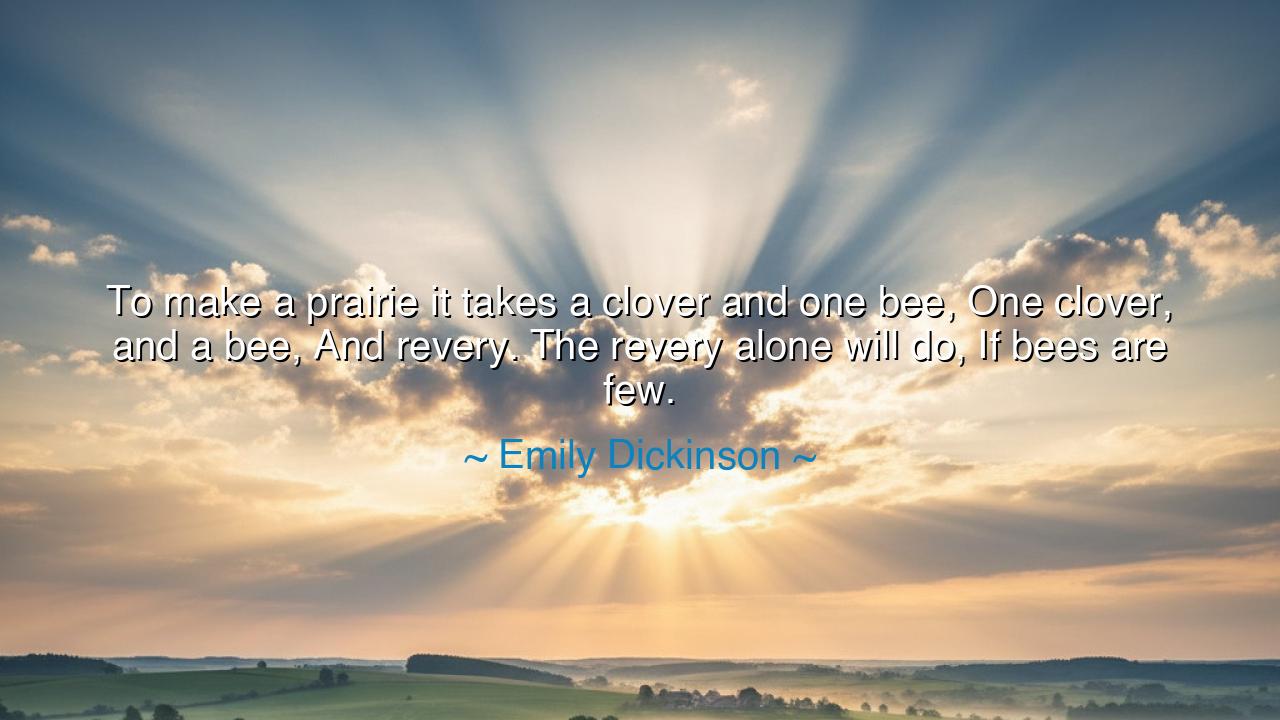
To make a prairie it takes a clover and one bee, One clover, and
To make a prairie it takes a clover and one bee, One clover, and a bee, And revery. The revery alone will do, If bees are few.






In the delicate, rhythmic dance of life, where every action, no matter how small, ripples across the fabric of the world, Emily Dickinson offers us a profound insight into the nature of creation. She wrote: “To make a prairie it takes a clover and one bee, One clover, and a bee, And revery. The revery alone will do, If bees are few.” These words, seemingly simple, echo a deeper truth about the essence of creation, imagination, and the quiet power of reflection. In a world that often seems to demand grand gestures and massive efforts, Dickinson reminds us that even the smallest of things—one clover, one bee—can be enough to bring forth a vast and beautiful world.
In the ancient wisdom of the philosophers, the notion of the small seed bearing great fruit was not unfamiliar. Heraclitus, the great thinker of the Ephesian school, taught that the universe is in a constant state of flux, and that from the smallest of changes, the greatest transformations can arise. Just as Heraclitus spoke of the river that changes with every drop, Dickinson speaks of the prairie, vast and beautiful, yet born from the smallest of elements—a clover and a bee. A world of vastness and life can spring from the quietest of moments, the smallest of contributions.
Consider the humble beginnings of the great empires of the past. The Roman Empire, which shaped much of the modern world, began as a small city-state, with a handful of citizens united by a common cause. It was not the wealth of kings nor the grand armies of the time that laid the foundations, but the collective action of a few individuals, guided by vision and imagination. In those early moments of Rome's rise, one might say it was the clover and the bee—the quiet visionaries, the ordinary citizens, and their dreams—that planted the seed for the grand civilization that followed.
The lesson here is profound: creation does not require grandiosity or abundance to begin; sometimes, it is the smallest acts that set the foundation for the greatest transformations. Dickinson’s words call us to embrace the power of simplicity—to understand that even in solitude, with just one small clover and one humble bee, we can create worlds of beauty and meaning. The revery—the dream and vision we carry in our hearts—becomes the catalyst for creation, and it does not need to be fueled by a multitude of resources. It is the visionary who, with little more than a dream, brings forth vast possibilities.
This truth is evident in the life of Vincent van Gogh, whose artistic journey was not marked by widespread acclaim or material wealth, but by the depth of his inner vision. His famous painting of sunflowers, a simple subject of nature, became a profound expression of the beauty he saw in the world around him. Despite limited resources and the absence of a thriving art world to support him, van Gogh’s revery—his dream of capturing life’s beauty—was enough. His art, born from a single brushstroke, has since inspired millions. Even when the bees were few, his revery alone was enough to create a vast, enduring legacy.
The true lesson of Dickinson’s verse is that creation begins with vision and imagination. The world around us is shaped not by the enormity of what we have, but by the depth of what we see. One clover, one bee, and a quiet dream—this is the foundation of all greatness. We are all capable of creating worlds of meaning and beauty, not through excess, but through the quiet, steady work of the imagination. Just as a single bee can pollinate an entire field of flowers, so too can a single vision change the course of a life.
In our own lives, we must embrace the power of simplicity and dreams. In a world that often values grand achievements and material success, let us remember that the smallest acts of creativity and imagination can have a profound impact. Start small, with one simple idea, one quiet vision, and allow it to grow. Like the clover and the bee, let our dreams take root in the fertile soil of revery, and trust that from them, great things will grow.
Finally, let us take action: In the quiet moments of our lives, when the world seems overwhelming and the task ahead too great, remember that creation begins with the smallest of steps. One idea, one dream, one act of kindness, can set the world in motion. Let us cultivate our dreams with patience, nurturing them with the care and dedication they deserve, knowing that even in the smallest of actions, we can make a vast difference in the world.






AAdministratorAdministrator
Welcome, honored guests. Please leave a comment, we will respond soon